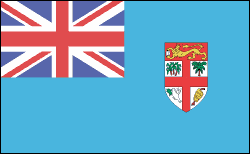FIJI

Geography: Fiji consists of 332 islands in the southwest Pacific Ocean about 1,960 mi (3,152 km) from Sydney, Australia. About 110 of these islands are inhabited. The two largest are Viti Levu (4,109 sq mi; 10,642 sq km) and Vanua Levu (2,242 sq mi; 5,807 sq km).
Government: Republic.
History: Fiji, which had been inhabited since the second millennium B.C. , was explored by the Dutch and the British in the 17th and 18th centuries. In 1874, an offer of cession by the Fijian chiefs was accepted, and Fiji was proclaimed a possession and dependency of the British Crown. In the 1880s large-scale cultivation of sugarcane began. Over the next 40 years, more than 60,000 indentured laborers from India were brought to the island to work the plantations. By 1920, all indentured servitude had ended. Racial conflict between Indians and the indigenous Fijians has been central to the small island's history.
Fiji became independent on Oct. 10, 1970. In Oct. 1987, Brig. Gen. Sitiveni Rabuka staged a coup to prevent an Indian-dominated coalition party from taking power. The military coup caused an exodus of thousands of Fijians of Indian origin who suffered ethnic discrimination at the hands of the government.
A new constitution, which took effect in July 1998, provided for a multiracial cabinet and raised the prospect of a coalition government. The previous constitution had guaranteed dominance to ethnic Fijians. In 1999, Fiji's first ethnic Indian prime minister, Mahendra Chaudhry, took office.
Government: Republic.
History: Fiji, which had been inhabited since the second millennium B.C. , was explored by the Dutch and the British in the 17th and 18th centuries. In 1874, an offer of cession by the Fijian chiefs was accepted, and Fiji was proclaimed a possession and dependency of the British Crown. In the 1880s large-scale cultivation of sugarcane began. Over the next 40 years, more than 60,000 indentured laborers from India were brought to the island to work the plantations. By 1920, all indentured servitude had ended. Racial conflict between Indians and the indigenous Fijians has been central to the small island's history.
Fiji became independent on Oct. 10, 1970. In Oct. 1987, Brig. Gen. Sitiveni Rabuka staged a coup to prevent an Indian-dominated coalition party from taking power. The military coup caused an exodus of thousands of Fijians of Indian origin who suffered ethnic discrimination at the hands of the government.
A new constitution, which took effect in July 1998, provided for a multiracial cabinet and raised the prospect of a coalition government. The previous constitution had guaranteed dominance to ethnic Fijians. In 1999, Fiji's first ethnic Indian prime minister, Mahendra Chaudhry, took office.

Map of Fiji
President: Ratu Epeli Nailatikau (2009)
Prime Minister: Frank Bainimarama (2007)
Total area: 7,054 sq mi (18,270 sq
km)
Population (2014 est.): 903,207
(growth rate: .7%); birth rate: 1986/1000; infant mortality rate:
10.2/1000; life expectancy: 72.15
Capital and largest city (2011 est.):
Suva (on Viti Levu), 177,000
Monetary unit: Fiji dollar
Languages:
English (official), Fijian (official), Hindustani
Ethnicity/race:
iTaukei 56.8% (predominantly Melanesian with a Polynesian
admixture), Indian 37.5%, Rotuman 1.2%, other 4.5% (European, part
European, other Pacific Islanders, Chinese)
note: a 2010 law replaces 'Fijian' with 'iTuakei' when referring to the original and native settlers of Fiji (2007 est.)
note: a 2010 law replaces 'Fijian' with 'iTuakei' when referring to the original and native settlers of Fiji (2007 est.)
Religions:
Protestant 45% (Methodist 34.6%, Assembly of God 5.7%,
Seventh Day Adventist 3.9%, and Anglican 0.8%), Hindu 27.9%, other
Christian 10.4%, Roman Catholic 9.1%, Muslim 6.3%, Sikh 0.3%, other
0.3%, none 0.8% (2007 est.)
National Holiday:
Independence Day, 2nd Monday of October
Literacy rate: 93.7% (2003 est.)
Economic summary: GDP/PPP (2013 est.):
$4.45 billion; per capita $4,900. Real growth rate: 3%. Inflation: 3%. Unemployment: 7.6%. Arable
land: 9.17%. Agriculture: sugarcane, coconuts, cassava
(tapioca), rice, sweet potatoes, bananas; cattle, pigs, horses, goats;
fish.
Labor force: 335,000; agriculture 70%, industry
and services 30%. Industries: tourism, sugar,
clothing, copra, gold, silver, lumber, small cottage industries.
Natural resources: timber, fish, gold, copper, offshore oil
potential, hydropower.
Exports: $1.026 billion (2013):
sugar, garments, gold, timber, fish, molasses, coconut oil.
Imports: $2.054 billion (2012): manufactured goods,
machinery and transport equipment, petroleum products, food,
chemicals. Major trading partners: U.S., Australia, UK, Samoa,
Japan, China, Tonga, New Zealand, Singapore.
Communications: Telephones: main lines in
use: 88,400 (2012); mobile cellular: 858,800. Broadcast media:
Fiji TV, a publicly traded company, operates a free-to-air channel as
well as Sky Fiji and Sky Pacific multi-channel pay-TV services;
state-owned commercial company, Fiji Broadcasting Corporation, Ltd,
operates 6 radio stations - 2 public broadcasters and 4 commercial
broadcasters with multiple repeaters; 5 radio stations with repeaters
operated by Communications Fiji, Ltd; transmissions of multiple
international broadcasters are available (2009). Internet hosts:
21,739 (2012). Internet users: 114,200 (2009).
Transportation: Railways: total: 597 km;
note: belongs to the government-owned Fiji Sugar (2008).
Highways: total: 3,440 km; paved: 1,692 km; unpaved: 1,748 km
(2011 est.). Waterways: 203 km; 122 km navigable by motorized
craft and 200-metric-ton barges (2012). Ports and harbors:
Lambasa, Lautoka, Suva. Airports: 28 (2013).
International disputes: none.
-------------------- o --------------------
No comments:
Post a Comment